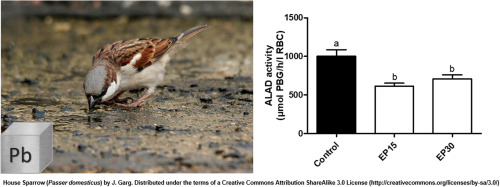Ecotoxicology and Environmental Safety ( IF 6.8 ) Pub Date : 2018-02-22 , DOI: 10.1016/j.ecoenv.2018.02.040 Fabricio D. Cid , Noelia C. Fernández , María V. Pérez-Chaca , Rafael Pardo , Enrique Caviedes-Vidal , Juan G. Chediack

|
House sparrows (Passer domesticus) have been proposed as a key ecological indicator of urban pollution. Remarkably, we lack knowledge about the physiological effects of lead on this bird species. Therefore, this study was aimed to evaluate the effect of Pb on several physiological parameters in house sparrows exposed to environmental Pb concentrations. In a first experiment, birds were exposed to Pb sub-lethal doses (from 1.3 to 14.0 µg of Pb/g animal/day) during 5 days, which resulted in a dose response increase of blood Pb levels and decrease of blood ALAD activity. However, at the higher doses tested (> 7 μg of Pb/g animal/day) the blood ALAD activity inhibition (~82%) remained constant. Hematocrit and hemoglobin were significantly reduced only at the highest-doses, and the stress indicator, heterophils to lymphocyte (H/L) ratio, did not show apparent changes.
In a second experiment, house sparrows were exposed to Pb in drinking water (12.3 ppm) during either 15 or 30 days. Pb concentration used in this study was enough to produce blood lead levels equivalents to those found recently in house sparrows inhabiting urban areas, reduced blood ALAD activity and inversion of the H/L ratio. Decreasing blood ALAD activities were correlated with increasing blood Pb levels. In addition, Pb exposure produced modification in the levels of hepatic antioxidant enzymes, increased GST activity and decreased CAT activity, without lipid peroxidation.
In conclusion, our results suggest that blood ALAD activity is a reliable and sensitive biomarker for environmental Pb exposure in house sparrows, additionally chronic exposure produce physiological stress (H/L inversion) and small changes in antioxidant enzyme activity. Finally, this specie could be considered a bioindicator for monitoring the urban Pb contamination.
中文翻译:

麻雀生物标志物作为铅污染生物指示剂。剂量和暴露时间对血液和氧化应激参数的评估
家麻雀(麻雀)已被提议作为城市污染的重要生态指标。值得注意的是,我们缺乏有关铅对这种鸟类的生理影响的知识。因此,本研究旨在评估铅对暴露于环境铅浓度的麻雀中几种生理参数的影响。在第一个实验中,鸟类在5天内暴露于Pb亚致死剂量(从1.3至14.0 µg Pb / g动物/天),这导致血Pb水平的剂量响应增加且血液ALAD活性降低。但是,在更高的测试剂量下(> 7μgPb / g动物/天),血液ALAD活性抑制(〜82%)保持恒定。血细胞比容和血红蛋白仅在最高剂量时才显着降低,应激指标,即嗜异性粒细胞与淋巴细胞(H / L)的比值没有显示出明显的变化。
在第二个实验中,麻雀在15或30天内暴露于饮用水(12.3 ppm)中的Pb。在这项研究中使用的铅浓度足以产生与最近在居住在城市地区的麻雀中发现的血铅水平相当的血铅水平,降低了血液中的ALAD活性和H / L比的倒置。血液ALAD活性下降与血液Pb水平升高相关。此外,铅的暴露引起肝脏抗氧化酶水平的改变,GST活性增加和CAT活性降低,而没有脂质过氧化作用。
总之,我们的结果表明,血液ALAD活性是麻雀中环境Pb暴露的可靠且敏感的生物标志物,此外,长期暴露会产生生理应激(H / L倒置)和抗氧化酶活性的微小变化。最后,该物种可以被视为监测城市铅污染的生物指标。



























 京公网安备 11010802027423号
京公网安备 11010802027423号